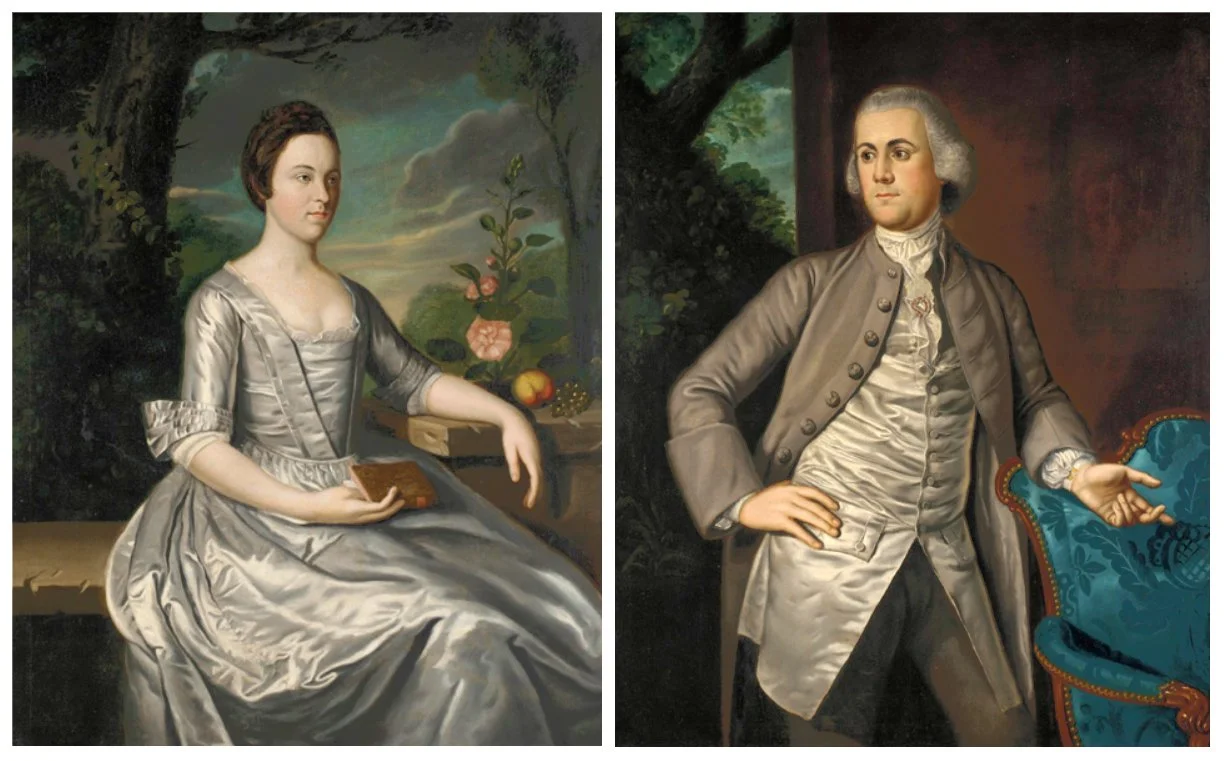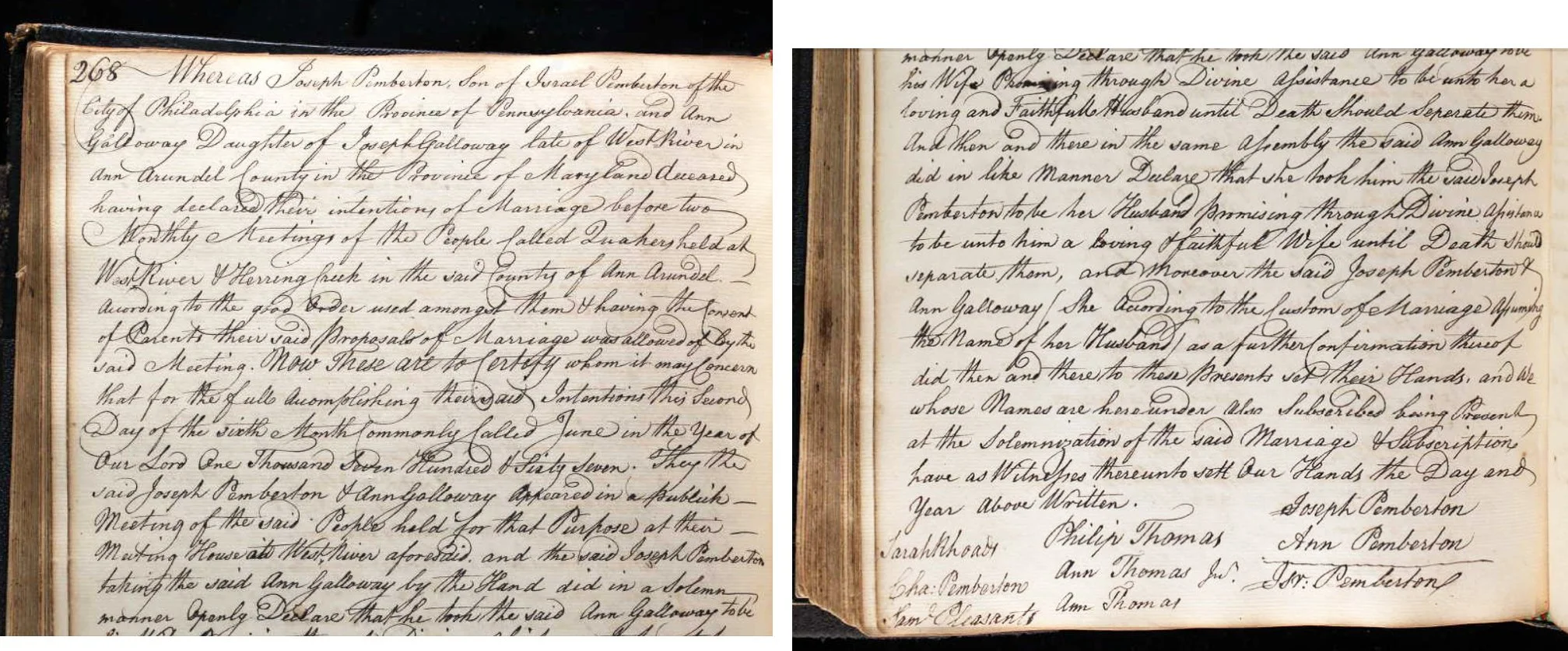Historic Quaker Houses of Philadelphia
The Pemberton House
316 Chestnut Street
Built: 1775. Demolished: 1840s. Rebuilt: 1968
Above: The Pemberton House in front of Carpenters’ Hall. Image source: Lee J. Stoltzfus
Original House built in 1775 by Quaker Merchant Joseph Pemberton
For His Young Family:
Above: Left: Ann (Galloway) Pemberton (1750 - 1798) and Joseph Pemberton (1745 - 1782). Portraits painted ca. 1767 by James Claypoole, Jr., presumably in honor of their marriage that year. The couple wears gray silk. The silk looks uniquely Philadelphia Quaker with its understated luxury.
The 1767 Marriage of Joseph and Ann Pemberton
In Quaker Meeting Records:
Above: Marriage record of Joseph and Ann Pemberton, at West River Meetinghouse, Arundel County, Maryland, on June 2, 1767. Image source: U.S., Quaker Meeting Records, 1681-1935, Ancestry.com
Birth of Their Son Charles Pemberton in 1776
While Living here in the Pemberton House:
Several generations of Pembertons were among the most prominent Quakers of Philadelphia. Joseph Pemberton was a merchant of sugar, wine, and other imports. He purchased this lot from the Carpenters’ Company headquartered next door. He then built the house for his young family in 1775. Unfortunately, the Joseph Pemberton’s financial downturn forced him to sell the house within a year. His business reversals resulting from interrupted commerce during the revolution.
After the Pembertons lived here, the house’s history includes:
ca. 1776 - Joseph Pemberton sold the house to merchant William Skyes.
1790 - Attorney Edward Tillman purchased the house for his home.
1816 to 1823 - Benjamin Franklin’s grandson, Richard Bache, operated a post office here.
1840s - House demolished and replaced by a larger building.
1968 - House was reconstructed for an Army-Navy museum, funded by the Army Association and the Navy League.
1997 - The Army-Navy Museum’s exhibits moved to New Hall.
1997 to 2013 - Pemberton Bookstore located here.
2018 - Independence Historic Trust relocated to this building.
The House’s Next-Door Neighbor
Carpenters’ Hall, Completed in 1774:
Above: Carpenters’ Hall is a next-door neighbor to the Pemberton House. It was constructed in 1774. During that same time, Joseph Pemberton purchased the lot for his house from the Carpenters’ Company. The association is a trade guild of architects, master builders, and engineers. It was founded in 1724, and it is the oldest craft guild in the U. S.
Many of the company’s first members were Quakers, whose ideals included offering fair wages and conducting honest business deals. Image source: Lee J. Stoltzfus
The Pemberton House
Rebuilt in the 1960s as an Army-Navy Museum.
Named a “Pentagon of the Past”
But it had been a Quaker Home, not a Military Building.
Image source: The Philadelphia Inquirer, Newspapers.com
In the 1960s the Pemberton House was named a “Pentagon of the Past” during a fund-raising campaign to reconstruct the house as an Army-Navy museum. The Pemberton House had been demolished in the 1840s, and was replaced a larger commercial structure. But the “Pentagon” name was historically incorrect, as the house had not been used for military purposes. Labelling that historic house as a “Pentagon” ignored the anti-war history of generations of pacifist Quakers who helped build the city.
In 1997 the Army-Navy Museum relocated away from the Pemberton House. Some exhibits moved next-door to the New Hall. Quaker historians undoubtedly were grateful that the Army-Navy Museum no longer occupied the Pemberton House.
Above: The Pemberton House was named “the Pentagon of the Revolution” to promote the rebuilding of the house as an Army-Navy museum in the 1960s. But the house had never been used for military purposes. It was originally built by the Quaker Pemberton family for their home.
Pacifist Philadelphia Quakers have a long history of being “Brothers of Non-Violence,” not “Brothers of Revolution,” despite the 1964 Navy headline above. Philadelphia patriots had even deported two Pemberton brothers and their nephew into exile during the Revolutionary War, for refusing to abandon their pacifist faith and values.
Today the Pemberton House is home to the Independence Historical Trust, the philanthropic partner of Independence National Historical Park. The organization beautifully interprets the history of Independence Park. Image source: Great Lakes Bulletin, 1964, Newspapers.com.







